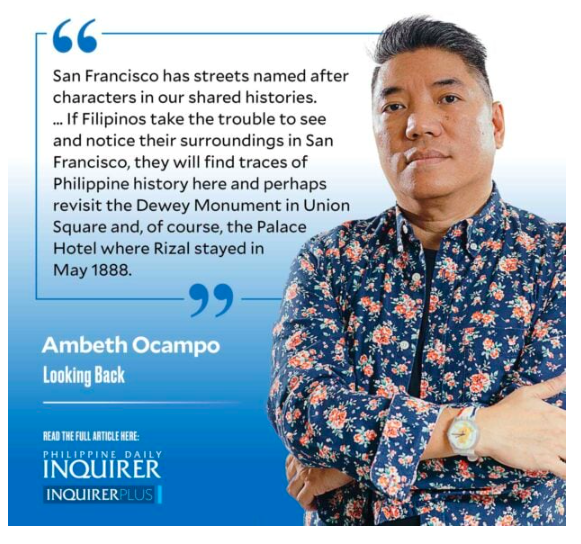Traces of Philippine history in SFO
San Francisco, California—On the way from the San Francisco International Airport to Berkeley last weekend, I remembered “The Streets of San Francisco,” a US TV series from my childhood. Street signs in this part of the world also reminded me that Manila and San Francisco are chartered sister cities, that both share a Spanish colonial past. After all, San Francisco, named after St. Francis of Assisi, is one of many cities in California whose names refer to Catholic saints like Santa Barbara, San Diego, and San Jose. Santa Fe is not a saint, it refers to “Holy Faith,“ the first of the three theological virtues: Fe (Faith), Esperanza (Hope), and Caridad (Charity) once popular Filipino names for girls. Los Angeles is named in honor of the guardian angels, or it could have been shortened from one of the Virgin Mary’s titles: Nuestra Señora Reina de los Angeles (Our Lady Queen of the Angels).
The next day, while returning to my hotel after dinner at the University of California Berkeley with Filipino historian Leloy Claudio and his wife, I pointed out a street named after Manila, prompting them to tell me that they live in a neighborhood with Bataan street. Curious, I checked out a city map and found Laguna street. This is not related to Laguna province in the Philippines, rather it is the Spanish word for “lagoon.” When people mistranslate the old name “Laguna de Bay” into Laguna Bay, I tell them that in Spanish, the letters “y” and “i” are interchangeable. For example, we know Isagani from textbook translations of Rizal’s “El Filibusterismo,” his name is spelled “Ysagani” in the original manuscript. Laguna de Bay is Laguna de Ba-i or the “lagoon, not lake, of Ba-i.”
San Francisco has streets named after characters in our shared histories. They have Magellan Avenue, a counterpart to Magallanes Avenue in Magallanes Village, Makati. They have Dewey Boulevard just as we did in Manila until it was renamed Heiwa during the Japanese Occupation and Roxas Boulevard in postwar times. George Dewey (1837-1917) was the hero of the Battle of Manila Bay. The first shot in the Spanish-American War did not occur anywhere near Madrid or Washington, it was heard half the world away in Cavite when then Commodore Dewey blasted the Spanish fleet under Admiral Patricio Montojo.
MacArthur Avenue in the Presidio is named after Arthur MacArthur Jr. (1845-1912) who was military governor of the Philippines at the turn of the 19th century when the islands exchanged hands from Spain to the US, going from one colonial power to another. Gen. Arthur MacArthur Jr.’s son Douglas MacArthur (1880-1964) also rose to the rank of general in the US Army and field marshal in the Philippine Army. He is best remembered for his “I shall return” promise to the Filipinos in World War II. Douglas is commemorated not as a street name but with the MacArthur Tunnel and the MacArthur Freeway.
If Manila had Plaza Lawton, renamed Liwasang Bonifacio, San Francisco has Lawton Street named in honor of Gen. Henry Ware Lawton (1843-1899), a veteran of the US Civil and Indian Wars and was the highest-ranking US military casualty of the Philippine-American War. Lawton was involved in the capture of the Apache chief Geronimo in 1866 but died in San Mateo in 1899 from a sniper under the command of Filipino Gen. Licerio Geronimo.
It is interesting to note that many of San Francisco’s Spanish-sounding street names were established when sentiment was rife against Spain, following the US victory in the Spanish-American War. Naming streets, while based on history and culture, is often a political act. So to recognize the large Filipino community in the city, there is a cluster of streets named after Philippine heroes. It begins with Lapu-lapu street, renamed from Lefty O’doul, and ends with heroes and a heroine of the 19th century: (Jose) Rizal Street, (Andres) Bonifacio Street, (Apolinario) Mabini Street, and Tandang Sora (Melchora Aquino) Street.
If Filipinos take the trouble to see and notice their surroundings in San Francisco, they will find traces of Philippine history here and perhaps revisit the Dewey Monument in Union Square and, of course, the Palace Hotel where Rizal stayed in May 1888.
Comments are welcome at [email protected]
Disclaimer: The comments uploaded on this site do not necessarily represent or reflect the views of management and owner of Cebudailynews. We reserve the right to exclude comments that we deem to be inconsistent with our editorial standards.

